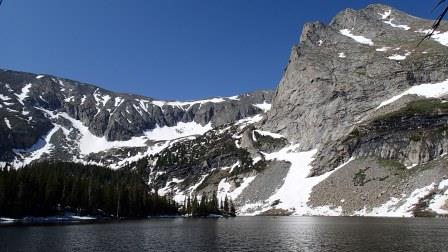In 1964, Congress created the Land and Water Conservation Fund (LWCF) to protect natural areas, water resources, and to provide recreation opportunities to all Americans. In its 50 year history, the LWCF has protected land in every state and helped support over 41,000 state and local parks. It has invested in public lands like Rocky Mountain National Park as well as supporting local community recreation resources and parks, cultural heritage sites, and working landscapes.Yet the authorization for this successful program expires on September 30, 2015 - and Congress has not yet acted to extend it. On July 30, the Senate Energy and Natural Resources Committee voted to send a bipartisan energy bill to the full Senate, but it still awaits that Senate vote. (Click here to contact your representatives today and urge them to support the LWCF.)

In Colorado, 77 percent of people are in support of the LWCF, the highest of any state.
Colorado has received $239 million in funds that have helped protect many state treasures like the Great Sand Dunes, Ophir Valley and Mesa Verde National Park- where $8.8 million in funds assisted in adding over 10,000 acres to the park since the year 2000. In return, outdoor recreation generates roughly $34.5 billion annually for the state.
To provide funds for recreation, LWCF uses revenues that stem from offshore oil and gas companies. Over $900 million is paid in royalties every year by these energy companies. However, in 50 years the LWCF has only been fully funded once, with Congress typically diverting some of the funds to other purposes.
While the LWCF has been an undisputed success in protecting public lands and promoting outdoor recreation, the program remains little known to many in the general public. To help tell some of the LWCF's Colorado success stories, Colorado TU has issued a report: Colorado's Great Outdoors - The Land and Water Conservation Fund in Colorado (click to open the report as a PDF file). Some examples of LWCF benefits to Colorado highlighted in the report include:
Fishing access & flood recovery. In 1976 when the Big Thompson River was 19 feet above its normal level, lives, homes and businesses were all lost. In the aftermath of the flood, the county went to the LWCF for just over $1 million in funds that the state would then match. With the new funds the County acquired 80 key properties along the Big Thompson for parks and angling access - properties that were not redeveloped and, when the river flooded again in 2013, helped avert an estimated $16 million in property damages.
The Town of Lyons was in a similar circumstance when the floods of 2013 hit. On September 12, the St Vrain Creek was flowing at 19,500 cubic feet per second- normally averaging at 67 CFS in September. The devastating floods caused damages of roughly $50 million and wiped out 39 acres of major park facilities- the main source of revenue for the town. Funding from the LWCF will help rebuild and extend the St Vrain Corridor Trail that provides recreational access along the St Vrain Creek.
Protecting iconic landscapes. President Herbert Hoover designated the Great Sand Dunes a national monument in 1932, but it would take nearly 70 years for the land to be recognized as a national park following the acquisition of the Baca Ranch. The designation was a direct result of grassroots efforts by residents of the San Luis Valley who recognized the unique landscape and the need to preserve it. The Great Sand Dunes, Baca National Wildlife Refuge, and the adjacent public lands all have benefited from LWCF funds in the past including with the critical initial acquisition of the Baca Ranch for the creation of the national park and preserve. Furthermore, Great Sand Dunes, Baca NWR, and the surrounding public lands have inholdings throughout the area, making management sometimes difficult because of the noncontiguous land pattern. LWCF funds have been used in the past to acquire some of these inholdings, easing management headaches and preserving this unique landscape.
According to surveys, 81 percent of voters approve of new land protection funding. In Colorado, Senators Michael Bennett and Cory Gardner are in full support of reauthorizing the LWCF to protect natural landscapes across the country for years to come. Members of Colorado’s House delegation are split on the issue.
Please visit the Action Center and urge your elected officials to reauthorize the LWCF!





